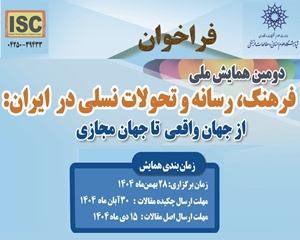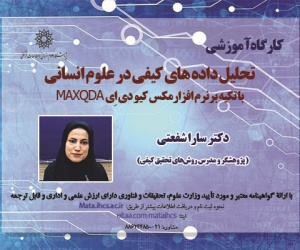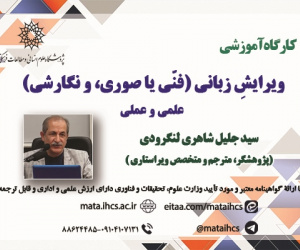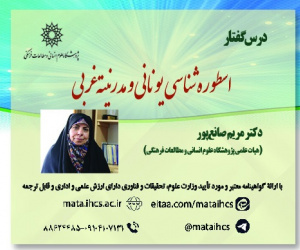کاوشی در روش های حقوقی و غیرحقوقی موثر برای فیصله ی اختلافات رسانه ای در داخل و خارج از محاکم دادگستری؛ (مطالعه تطبیقی: ایران و آمریکا) (مقاله علمی وزارت علوم)
درجه علمی: نشریه علمی (وزارت علوم)
آرشیو
چکیده
موضوع: اختلافات رسانه ای به ویژه در دنیای معاصر که با سرعت انتشار اطلاعات روبه رو هستیم، یکی از چالش های عمده نظام های حقوقی و قضائی در سرتاسر جهان به شمار می روند. رسانه ها به عنوان یک ابزار تاثیرگذار در جامعه، اغلب در معرض شکایات و دعاوی مختلف قرار می گیرند که این دعاوی ممکن است جنبه های حقوقی، اقتصادی و اجتماعی داشته باشند. در این میان، روش های قانونی و غیرحقوقی مختلفی برای حل این اختلافات وجود دارد که هرکدام ویژگی ها و پیچیدگی های خاص خود را دارند. پرسش اصلی این تحقیق آن است که «چه روش های قانونی و غیرحقوقی مرسومی برای فیصله اختلافات رسانه ای وجود دارد؟» و در این راستا، به ویژه این پرسش مطرح می شود که «چگونه دادگستری خصوصی می تواند تضمین کننده کیفیت، امنیت و ضمانت اجرایی لازم برای حل اختلافات رسانه ای باشد؟» هدف این تحقیق بررسی و تحلیل این روش ها، به ویژه با مطالعه تطبیقی نظام های حقوقی جمهوری اسلامی ایران و ایالات متحده آمریکا است. در این پژوهش، ضمن تحلیل روش های قانونی، همچون سیستم تسویه حساب، روش های غیرحقوقی همچون داوری و حل اختلافات به صورت داوطلبانه نیز بررسی خواهد شد. در این تحقیق، تأکید بر این نکته است که، علاوه بر فرایندهای قضائی، روش های غیرحقوقی می توانند به طور قابل توجهی در کاهش حجم پرونده های دادگستری و همچنین حل و فصل اختلافات رسانه ای به روشی مسالمت آمیز و موثر کمک کنند. با توجه به پیچیدگی ها و تنوع دعاوی رسانه ای، استفاده از این روش ها می تواند به حل مشکلات به ویژه در زمینه هایی که جنبه های تخصصی دارند، کمک کند. روش تحقیق: این پژوهش، تحلیلی و توصیفی است و با استفاده از مطالعه تطبیقی، به بررسی روش های حقوقی و غیرحقوقی حل اختلافات رسانه ای در دو نظام حقوقی جمهوری اسلامی ایران و ایالات متحده آمریکا پرداخته می شود. برای این منظور، ابتدا به جمع آوری اطلاعات مربوط به قوانین و مقررات حاکم بر رسانه ها در هر دو کشور پرداخته شده و سپس روش های حل اختلافات رسانه ای در هر کدام از این نظام ها تحلیل می شود. در بخش اول، اطلاعات از طریق مطالعه متون قانونی، آیین نامه ها، و دستورالعمل های قضائی مربوط به رسانه ها در هر دو کشور جمع آوری می شود. این اطلاعات شامل قوانین شکایت رسانه ای، فرآیندهای دادرسی، و روش های جایگزین حل اختلاف در نظام های حقوقی ایران و ایالات متحده است.در بخش دوم، روش های غیرحقوقی حل اختلافات مانند داوری، تسویه حساب، و فرآیندهای جایگزین، بررسی شده و مقایسه ای بین کاربرد این روش ها در ایران و آمریکا صورت می گیرد. برای این منظور، از منابع ثانویه شامل مقالات علمی، گزارش ها، و تحلیل های موجود در این زمینه استفاده می شود. همچنین، با بهره گیری از تحلیل های تطبیقی، شباهت ها و تفاوت های میان دو نظام حقوقی از نظر مدیریت و حل اختلافات رسانه ای بررسی می شود. روش تحقیق همچنین شامل تحلیل موارد واقعی و پرونده های نمونه از دو کشور است تا نشان دهد که چگونه سیستم های حقوقی مختلف می توانند به طور مؤثر یا ناکارآمد در حل اختلافات رسانه ای عمل کنند. در نهایت، این پژوهش از روش های کیفی برای تحلیل داده ها استفاده می کند و نتایج حاصل از مقایسه تطبیقی و تحلیل پرونده های نمونه را برای پیشنهاد بهبود روش های حل اختلافات رسانه ای ارائه می دهد. یافته ها: تایج این پژوهش نشان می دهد که روش های قانونی و غیرحقوقی مختلف برای حل اختلافات رسانه ای به طور گسترده در کشورها و نظام های مختلف به ویژه در ایران و آمریکا مورد استفاده قرار می گیرند. در ایران، برخی از این روش ها، همچون دادگاه های عمومی رسانه ای، همچنان به طور سنتی در حال اجرا هستند، در حالی که در ایالات متحده، قوانین و روش های جدیدتری چون سیستم تسویه حساب و داوری رسانه ای مطرح شده است. مطالعه تطبیقی دو نظام حقوقی ایران و ایالات متحده نشان می دهد که در ایالات متحده آمریکا، روش های جایگزین حقوقی همچون سیستم تسویه حساب، که در آن طرفین به صورت داوطلبانه از طریق شخص ثالث به حل اختلاف می پردازند، توانسته است موفقیت هایی در کاهش حجم پرونده های دادگستری داشته باشد. این روش ها علاوه بر کاهش بار دادگستری، به حل مسالمت آمیز اختلافات کمک می کنند و از طرفی می توانند اطمینان حاصل کنند که طرفین به تصمیمات نهایی پایبند خواهند بود. در جمهوری اسلامی ایران، با توجه به ساختار حقوقی خاص و تفاوت های موجود در قوانین رسانه ای، بسیاری از این روش ها کمتر کاربرد دارند. با این حال، در سال های اخیر، برخی از این مدل های حقوقی مانند داوری در اختلافات رسانه ای در حال معرفی و استفاده قرار گرفته اند. این مدل ها به ویژه در مواقعی که اختلافات رسانه ای پیچیده و نیاز به تخصص دارند، مفید واقع می شوند. نتایج این پژوهش همچنین نشان می دهد که سیستم های حقوقی باید توجه ویژه ای به حقوق متهمان رسانه ای و همچنین نیاز به حفظ منافع عمومی و شفافیت در فرآیندهای قضائی داشته باشند. به همین دلیل، روش های غیرحقوقی در بسیاری از موارد می توانند نقش مکملی برای دادگاه ها ایفا کنند. بحث و نتیجه گیری: بحث در این زمینه نشان می دهد که روش های حقوقی و غیرحقوقی می توانند به طور قابل توجهی در فیصله اختلافات رسانه ای موثر باشند. در حالی که دادگاه های سنتی ممکن است به دلیل فرآیند طولانی و پیچیدگی های خود قادر به حل سریع و مؤثر دعاوی رسانه ای نباشند، روش های غیرحقوقی مانند داوری و سیستم های تسویه حساب به عنوان گزینه های مفید و کارآمد در کاهش بار دادگستری مطرح شده اند .در ایالات متحده، سیستم تسویه حساب، به ویژه در موارد مربوط به رسانه ها، به دلیل انعطاف پذیری بالا و امکان دستیابی به توافقات سریع و قابل اجرا، به طور گسترده استفاده می شود. این روش با توجه به طبیعت مشاجرات رسانه ای، که ممکن است اغلب به صورت فنی و تخصصی باشند، به ویژه مفید است. در جمهوری اسلامی ایران، باوجود پیشرفت هایی در زمینه استفاده از روش های غیرحقوقی، هنوز این روش ها به طور کامل در سیستم قضائی رسانه ای پذیرفته نشده اند. اما با توجه به ظرفیت های موجود و نیاز به حل سریع و کم هزینه اختلافات، می توان از این مدل ها در کنار روش های قضائی استفاده کرد. در نهایت، تحقیق حاضر نشان می دهد که برای تضمین کیفیت، امنیت و اجرای بهتر تصمیمات، استفاده از ترکیبی از روش های قانونی و غیرحقوقی ضروری است. علاوه بر این، نهادهای قضائی باید به تدریج از این روش های غیرحقوقی حمایت کنند و فرآیندهای قضائی را به گونه ای طراحی کنند که هم پاسخگوی نیازهای رسانه ها باشد و هم از شفافیت و عدالت برخوردار باشد.An Exploration of Effective Legal and Non-Legal Methods for Resolving Media Disputes Inside and Outside Courts of Justice (Comparative Study: Iran and the United States)
Media disputes, especially in the contemporary world where we are faced with the rapid dissemination of information, are considered one of the major challenges for legal and judicial systems around the world. As an influential tool in society, the media is often subject to various complaints and lawsuits, which may have legal, economic, and social aspects. Meanwhile, there are various legal and non-legal methods for resolving these disputes, each with its own characteristics and complexities. The main question of this research is: "What are the common legal and non-legal methods for resolving media disputes?" In this regard, the question is specifically raised: "How can private justice guarantee the quality, security, and enforcement guarantees necessary for resolving media disputes?" This research aimed to examine and analyze these methods, especially through a comparative study of the legal systems of the Islamic Republic of Iran and the United States of America. In this research, in addition to analyzing legal methods, such as the settlement system, non-legal methods such as arbitration and voluntary dispute resolution were also examined. This research emphasizes that, in addition to judicial processes, non-legal methods can significantly help reduce the number of court cases and also resolve media disputes peacefully and effectively. Given the complexities and diversity of media litigation, the use of these methods can help resolve problems, especially in fields that have specialized aspects.
Research Method: This research is analytical and descriptive, and using a comparative study, it examines legal and non-legal methods of resolving media disputes in the two legal systems of the Islamic Republic of Iran and the United States of America. For this purpose, first, information was collected regarding the laws and regulations governing the media in both countries and then the methods of resolving media disputes in each of these systems were analyzed. In the first part, information was gathered through a study of legal texts, regulations, and judicial guidelines related to the media in both countries. This information includes media complaint laws, litigation processes, and alternative dispute resolution methods in the Iranian and US legal systems. In the second part, non-legal dispute resolution methods such as arbitration, conciliation, and alternative processes were examined and a comparison was made between the use of these methods in Iran and the United States. For this purpose, secondary sources including academic articles, reports, and analyses available in this field were used. Also, by using comparative analysis, the similarities and differences between the two legal systems in terms of managing and resolving media disputes were examined. The research methodology also includes the analysis of real cases and sample cases from the two countries to show how different legal systems can function effectively or ineffectively in resolving media disputes. Finally, this research used qualitative methods to analyze data and presented the results of comparative comparison and analysis of sample cases to suggest improvements in media dispute resolution methods.
Findings: The results of this study showed that various legal and non-legal methods are widely used to resolve media disputes in different countries and systems, especially in Iran and the United States. In Iran, some of these methods, such as public media courts, are still being implemented traditionally; while in the United States, recently developed laws and methods, such as the media settlement and arbitration system, have been presented. A comparative study of the two legal systems of Iran and the United States shows that in the United States, alternative legal methods such as the settlement system, in which the parties voluntarily resolve disputes through a third party, have been successful in reducing the number of court cases. In addition to reducing the burden on the judiciary, these methods help resolve disputes peacefully and can ensure that the parties will adhere to the final decisions. In the Islamic Republic of Iran, due to the specific legal structure and differences in media laws, many of these methods are less applicable. However, in recent years, some of these legal models, such as arbitration in media disputes, have been introduced and applied. These models are particularly useful in situations where media disputes are complex and require expertise. The results of this research also show that legal systems should pay special attention to the rights of media defendants, as well as the need to protect the public interest and transparency in judicial processes. For this reason, non-legal methods can play a complementary role to the courts in many cases.
Discussion and Conclusion: The discussion in this context showed that legal and non-legal methods can be significantly effective in resolving media disputes; while traditional courts may not be able to resolve media disputes quickly and effectively due to their lengthy process and complexities. Non-legal methods such as arbitration and settlement systems have been proposed as useful and efficient options for reducing judicial workload. In the United States, the settlement system is widely used, particularly in media cases, due to its high flexibility and the ability to reach quick and enforceable agreements. This method is particularly useful given the nature of media disputes, which can often be technical and specialized. In the Islamic Republic of Iran, despite advances in the use of non-legal methods, these methods have not yet been fully accepted in the media judicial system; however, given the existing capacities and the need for quick and low-cost resolution of disputes, these models can be used alongside judicial methods. At last, the present research showed that to ensure quality, security, and better implementation of decisions, it is necessary to use a combination of legal and non-legal methods. Furthermore, judicial institutions should gradually support these non-legal methods and design judicial processes in a way that both meets the needs of the media and is transparent and fair.








